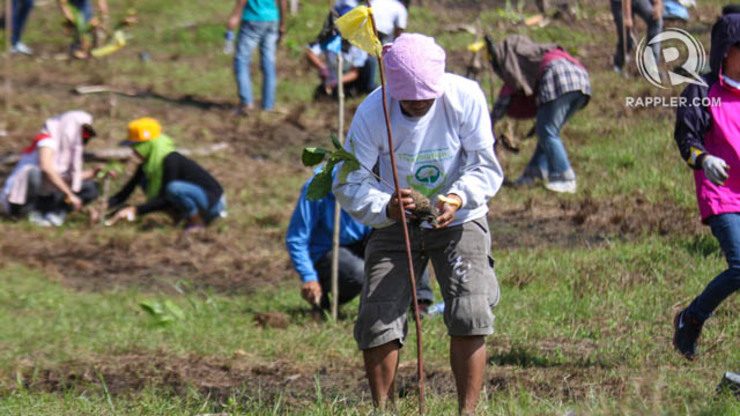SUMMARY
This is AI generated summarization, which may have errors. For context, always refer to the full article.

DAVAO CITY, Philippines – Thousands of residents from all walks of life across Mindanao traversed hills and crossed rivers at dawn Friday, September 26, for two missions: help the environment and bag a world record.
The “TreeVolution: Greening MindaNOW” campaign seeks to plant 4.6 million trees across Mindanao covering a total of 9,200 hectares within an hour and earn the Guinness World Record for Most Trees Planted Simultaneously in multiple locations.
Initiated by the Mindanao Development Authority (MinDA) and the Department of Environment and Natural Resources (DENR), the campaign has to top the current world record held by India, which planted 1.9 million trees within an hour in 2011.
As of 5 pm Friday, Mindanaoans had counted more than 3 million trees – 3,058,625 to be exact – according to MinDA.
“The response from Mindanao is so heartwarming. Let us show how important awareness of the environment is. Our parents said that the best inheritance is education. No, the best inheritance are twins and they are education and the environment,” MinDa Secretary Lualhati Antonino said.
Antonino explained that the campaign is an effort to “pay back” for the damage caused by man to the environment after decades of destructive practices.
The idea for a Mindanao campaign started with the realization that the island has to take drastic steps in environmental management after the destruction brought by typhoons Sendong and Pablo, Antonino added.
“While we are aiming to create a new Guinness World Record with Treevolution, what is more critical is for us to reforest Mindanao,” she said.
DENR Undersecretary Demetrio Ignacio said the Treevolution is a “Mindanao-style” tree planting, which is part of the government’s National Greening Program. (READ: DENR chief grilled on reforestation program)
To ensure that the communities will directly benefit from it, Ignacio shared that many of the trees planted were fruit trees like cacao and coffee.
Most of the trees will bear fruits in 3 years and the host communities may consume or sell them, Ignacio said. (READ: Is the gov’t reforestation program planting the right trees?)
To ensure the survival of the newly planted trees, Ignacio explained that the residents of the host communities will be employed as caretakers under the cash-for-work program of the Department of Social Welfare and Development (DSWD).
“They will be hired to maintain the trees. And their salary will be based on minimum wage,” Ignacio said.
Antonino added that she has already discussed it with DSWD Secretary Corazon Soliman and that they have agreed to work together in institutionalizing environmental service.
“This is a good thing because this is not just anti-poverty but it will also preserve our environment,” Antonino said.
A call for climate justice
Meanwhile, the environmental group Panalipdan commented that environmental campaigns like the Treevolution should go beyond establishing world records and “making it a publicity stunt,” and instead address climate injustice.
“Since it is supposed to be a revolution, it should undergo contextual analysis of climate injustice…by the people who are most affected by the issues of injustices. The people identify and analyze the multiple problems and should find their own solutions,” said Panalipdan convener Dr. Jean Lindo.
For it to be successful, a “treevolution” should be people-centered and not be done to favor corporations because they are required carbon sink, Lindo commented. (READ: Rethinking the National Greening Program)
“The people’s output should not be part of that required of the corporations. We have different responsibilities and more is required of those who use the most resources,” Lindo said.
With the present rise in the applications for coal-fired power plants in Mindanao, Panalipdan said efforts to plant more trees would not win over the increase in volume of carbon emission.
“The program planners should be aware that the treevolution is not cure all. It will not succeed if coal energy continues. It must be noted that coal-fired power plants contribute 40% of carbon emission and this has led to exceeding the limit of 350 parts per million of carbon in the atmosphere. The level is now at 400 parts per million. We simply cannot plant our way out of carbon pollution. Fossil fuel has to be reduced dramatically,” Lindo said.
At present, the 645 MW coal-fired power plant owned by AboitizPower subsidiary Therma South Incorporated in Davao City is nearing completion, while the first unit of the 200 MW Southern Mindanao Coal-fired Power Station in Maasim, Sarangani, will be online by the 3rd quarter of 2015.
By the end of 2015, the first unit of the 300 MW coal plant owned by the San Miguel Consolidated Power Corporation in Malita, Davao del Sur, will be operational.
In Villanueva town in Misamis Oriental, a 405 MW coal plant is also being constructed by the Filinvest Development Corporation and is expected to start operations in 2015.
A 210 MW coal plant by STEAG State Power Corporation is presently operational in the same town.
All of these coal-fired power plants are supported and publicly defended by the MinDa, which is one of the main organizers of the Treevolution campaign. – Rappler.com
Add a comment
How does this make you feel?
There are no comments yet. Add your comment to start the conversation.